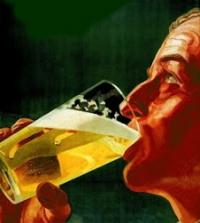
Has anyone used the Hochkurz mash schedule
#1

Posted 22 June 2011 - 01:10 PM
#2

Posted 22 June 2011 - 01:44 PM
#3

Posted 22 June 2011 - 01:54 PM
#4

Posted 22 June 2011 - 02:01 PM
Mouthfeel, yes. Maltiness, no. You should get some body and mouthfeel from the higher rest but not maltiness.I've heard people say that the lower-temp mash ensures good fermentability and attenuation and then the higher-temp mash gives the beer some maltiness & mouthfeel.
Exactly. Remember that mashing is just a continuation of the malting process. If malts are malted differently today than they were in the past, then they also require a different mash than what was once necessary.I've tried this mash (although I didn't know it had a name) and I'd have to agree with Denny. It would be hard to find a difference without a blind test. The first rest should convert the hell out of straight starch chains. The only dextrins left would be branched starches that the beta amylase couldn't get at. The higher rest then would break those chains and also fragment any long straight-chain dextrins left over from the first rest into randomly-sized straight chains. If you do a single infusion, you have both processes going on at once (at different rates) so when the branched dextrins get cleaved, the beta amylase can take those straight chains and turn them into maltose.I always go back to the fact that many people say that these are things that brewers did over 100 years ago because they had to & because of heavily modified malts that are available today, we (as homebrewers) do not have to do these things.
#5

Posted 22 June 2011 - 02:54 PM
#6

Posted 22 June 2011 - 03:06 PM
#7

Posted 22 June 2011 - 03:21 PM
#8

Posted 22 June 2011 - 03:28 PM
Isn't that why he says 1.25 - 1.5 qts/lb to start?
#9

Posted 22 June 2011 - 03:54 PM
No worries... I may have to try this, just to see how it goes.
Yeah, I saw 1.75 - 2.25 but that was for direct heat.
#10

Posted 22 June 2011 - 05:36 PM
#11

Posted 22 June 2011 - 05:51 PM
I know traditional pilsners (with a decoction) are brewed with a thin mash. I think this is so the mash will maintain its heat and not lose temperature when a big chunk of the mash is removed for the decoction. But yeah, if you're trying to do a step infusion, start out as stiff as you can.I usually mash with less water anyway so I would go with a thicker mash for the first mash and then add boiling water until I reached the second mash temp. I made a German Pilsner last month where the mash called for 4.50 gallons of water for 10lbs of grain which is 1.8 qts/lb which is quite a bit higher than I would normally go. I read someplace that Germans use a thinner mash consistency. I don't know but again, seems easy enough to try it out to see what the results might be. I will post back if I try it.
#12

Posted 22 June 2011 - 08:33 PM
#13

Posted 23 June 2011 - 05:17 AM
#14

Posted 23 June 2011 - 08:30 AM
#15

Posted 23 June 2011 - 09:41 AM
#16

Posted 23 June 2011 - 09:51 AM
Wasn't this mash sequence made up by some guy named Mike? You know, Mike Hochkurz. Awww c'mon. Someone had to do it. I couldn't read the title of the thread one more time without doing something about it.
1 user(s) are reading this topic
0 members, 1 guests, 0 anonymous users











